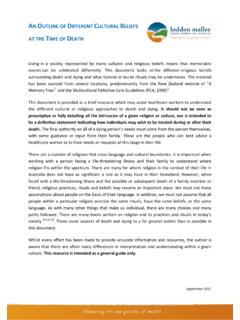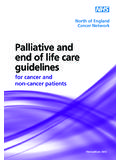Transcription of Essential Medicines in Palliative Care - who.int
1 0 World Health Organization Essential Medicines in Palliative care EXECUTIVE SUMMARY Prepared by: International Association for Hospice and Palliative care (IAHPC) January 2013 Contact information: Liliana De Lima, MHA Executive Director Essential Medicines in Palliative care (January 2013) 1 TABLE OF CONTENTS SECTION PAGE Background 2 WHO definition of Palliative care 2 Objectives 3 Methods 3 Main Results 4 Summary of Recommendations Anorexia 5 Anxiety 5 Constipation 5 Delirium 6 Depression 6 Diarrhoea 6 Dyspnoea 7 Fatigue 7 Nausea and vomiting 7 Pain 8 Respiratory tract secretions 8 Table 1 GRADE system 9 Table 2 Summary of recommended Medicines in Palliative care 10 References for executive summary 13 Appendix - Monographs and Summary of the Evidence Anorexia 16 Anxiety 20 Constipation 24 Delirium 29 Depression 33 Diarrhoea 40 Dyspnoea 44 Fatigue 49 Nausea and vomiting 55 Pain 61 Respiratory tract secretions 68 WHO EML.
2 Palliative care January 2013 2 BACKGROUND The World Health Organization (WHO) defines Essential Medicines are those which satisfy the primary health care needs of the population. To advance application of the concept, the WHO also developed a Model List of Essential Medicines (EML) which is updated every two years, and is based on the criteria of safety, efficacy and cost effectiveness of each medicine listed. The concept and the EML are presented to countries as expert guidelines which they can use to develop their own Essential Medicines policies and lists. The current EML includes specific recommendations for Palliative care in children, but none for adults. In 2007, in response to a request from the World Health Organization (WHO), the International Association for Hospice and Palliative care (IAHPC) developed a List of Essential Medicines for Palliative care based on the consensus of Palliative care workers from around the world.
3 IAHPC designed a process of five steps, which included developing a set of ethical guidelines; identifying the most common symptoms in Palliative care ; identifying a list of Medicines to treat those symptoms; carrying out a survey using a modified Delphi process with more than 300 participants from 56 countries; and convening a meeting of representatives from 26 regional, international, and scientific pain and Palliative care organizations to develop the final list. Twenty-one symptoms were identified as the most common in Palliative care , and 33 Medicines were included in the IAHPC List of Essential Medicines for Palliative care (De Lima, 2007). This list was presented to the 16th WHO Expert Committee on the selection and use of Essential Medicines in 2007 to be considered for inclusion in the Palliative care section.
4 However, this list was not based on scientific evidence but on expert opinion. Therefore the expert committee decided to include the following statement in the Palliative care section of the EML which still appears: The WHO Expert Committee recognizes the importance of listing specific Medicines in the Palliative care Section. Some Medicines currently used in Palliative care are included in the relevant sections of the Model List, according to their therapeutic use, analgesics. The Guidelines for Palliative care that were referenced in the previous list are in need of update. The Committee expects applications for Medicines needed for Palliative care to be submitted for the next meeting (WHO 2011). Other Palliative care organizations and institutions have identified or developed lists of Essential Medicines for Palliative care but with the exception of one recently developed in Germany, all have been based on expert opinion (Lindqvist et al 2013; Merriman et al 2012; Good et al.)
5 2005; Nauck et al, 2004). In 2008, a group of paediatric Palliative care specialists submitted an application for a list of Essential Medicines for the WHO EML (children) (Aindow and Brooke 2008). This application included a list of the most distressing symptoms in paediatric Palliative care and recommended 17 Medicines to be included in the EML (children). In the fall of 2012, the Department on the Selection and use of Essential Medicines requested the IAHPC to prepare a summary of available evidence in support of the development of a List of Essential Medicines for Palliative care to ensure access to appropriate Medicines for the pharmacological management of the most prevalent and distressing symptoms in adult patients with life threatening and life-limiting conditions worldwide.
6 This document summarizes the methodology followed, the main findings and results of the process and the recommended Medicines and formulations needed for the treatment of each symptom. This application does not offers recommendations for the treatment of underlying diseases or conditions, only the symptoms associated with the disease and/or its treatment. DEFINITION OF Palliative care (WHO, 2002) Palliative care is an approach that improves the quality of life of patients and their families facing the WHO Essential Medicines in Palliative care (January 2013) 3 problem associated with life-threatening illness, through the prevention and relief of suffering by means of early identification and impeccable assessment and treatment of pain and other problems physical, psychosocial and spiritual.
7 Palliative care : provides relief from pain and other distressing symptoms; affirms life and regards dying as a normal process; intends neither to hasten or postpone death; integrates the psychological and spiritual aspects of patient care ; offers a support system to help patients live as actively as possible until death; offers a support system to help the family cope during the patients illness and in their own bereavement; uses a team approach to address the needs of patients and their families, including bereavement counselling, if indicated; will enhance quality of life, and may also positively influence the course of illness; is applicable early in the course of illness, in conjunction with other therapies that are intended to prolong life, such as chemotherapy or radiation therapy, and includes those investigations needed to better understand and manage distressing clinical complications.
8 Life threatening illness is used to describe illnesses where it is expected that death will be a direct consequence of the specified illness. (Australian Government Department of Health and Ageing, 2012). OBJECTIVES To identify the most important symptoms in Palliative care , taking into account prevalence and associated distress To identify appropriate pharmacological approaches for management of individual symptoms To determine effectiveness and safety of identified pharmacological approaches METHODS A Working Group (WG) of directors from the IAHPC was formed to work on this project. Members of the WG include Michael I. Bennett (UK), James Cleary (USA), David Currow (Australia), Liliana De Lima (USA), Arthur Lipman (USA), and Scott Murray (UK). Tania Pastrana (Germany) was invited as research consultant.
9 The group was chaired by Lukas Radbruch (Germany) and coordinated by LDL. Step 1: Identification of the most common causes of death: The WHO Global mortality data was used to identify the main causes of mortality. Step 2: Identification of the most common and distressing symptoms in Palliative care : Based on these results, an electronic search strategy was utilized to identify the most common symptoms occurring in the identified causes of mortality: MEDLINE (2000 - 2012) EMBASE (2000 - 2012) Hand search of the references included in studies/papers identified from above Hand search of specialist Palliative care journals: American Journal of Hospice and Palliative care , European Journal of Palliative care , Journal of Hospice and Palliative Nursing, Journal of Pain and Symptom Management, Journal of Pain and Palliative care Pharmacotherapy, Journal of Palliative care , Palliative Medicine, Palliative Nursing, and Supportive care in Cancer.
10 Hand searches of white papers and government reports. Step 3: Identification of the Medicines recommended for the treatment of the symptoms: The WG identified the evidence for the pharmacological treatment of the symptoms identified in Step 1 and using data provided by a study commissioned to the Palliative care Group in Bonn by the German Drug Commission, supplemented by evidence based reviews and evidence based WHO Essential Medicines in Palliative care (January 2013) 4 guidelines provided by members of the WG, a process was undertaken to identify evidence to support the pharmacological management of these symptoms. Only meta- analyses and systematic reviews specific to the pharmacological management of the identified symptom Palliative care were sought. Additional literature based on expert opinion was sought on the MEDLINE and EMBASE databases mentioned above.












